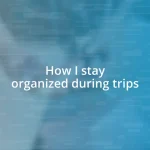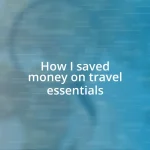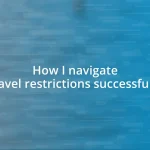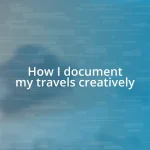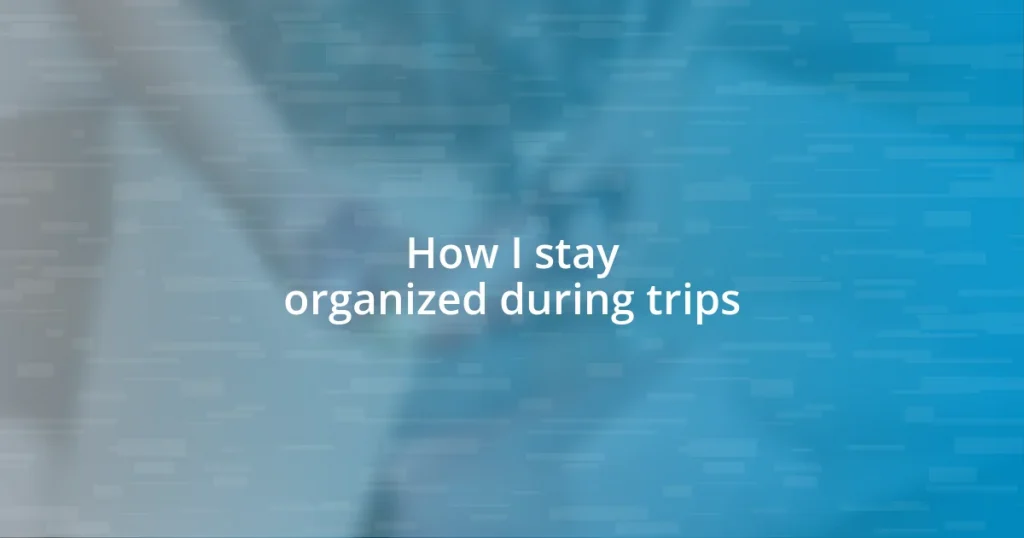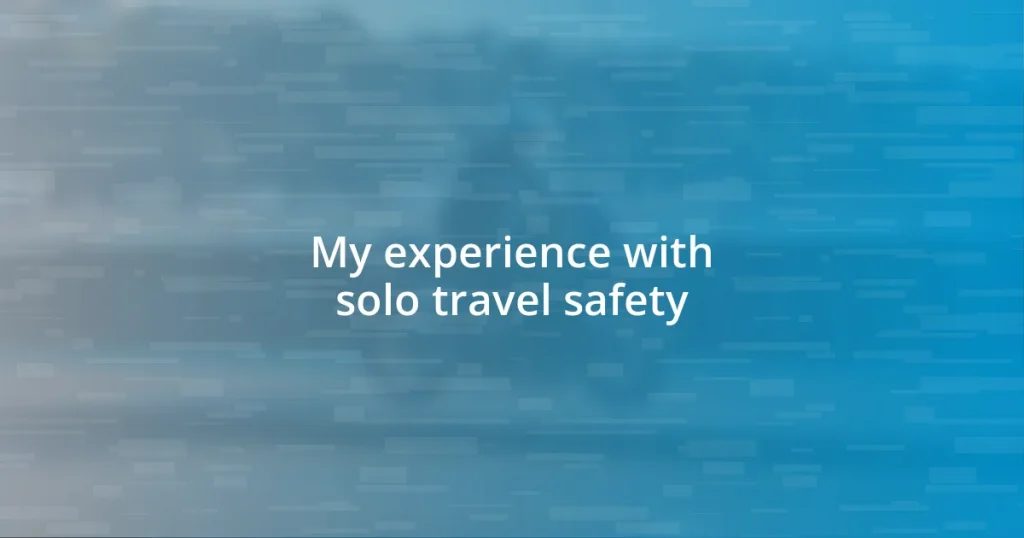Key takeaways:
- Planning trips in advance creates a narrative, reducing stress and enhancing anticipation for the adventure.
- Creating a detailed itinerary with essential information, prioritization, and backup plans enriches the travel experience.
- Effective digital tools and organized document management streamline travel preparations and foster collaboration during group trips.

Planning trips in advance
When I plan my trips in advance, it often feels like crafting a story. I remember one particular trip to Italy; I spend evenings mapping out my itinerary, looking at each site not just as a place to visit, but as a part of a beautiful narrative waiting to unfold. Isn’t it exciting to see how everything fits together, like pieces of a puzzle?
I also find that an organized approach alleviates the stress that can creep in closer to departure. For instance, on a recent hiking trip, having mapped out my trail routes and packed my gear a week ahead not only saved me time but also allowed me to bask in the excitement of the adventure without the last-minute frenzy. Can you recall a time when you felt rushed before a trip?
One of my favorite tools for planning is a travel app that gives me a visual layout of my itinerary. It’s like having a personal assistant in my pocket! It helps me stay focused and lets me enjoy the anticipation, knowing I have everything lined up. Do you have a go-to method that makes your trip planning smoother?

Creating a detailed itinerary
Creating a detailed itinerary can feel a bit overwhelming, but I see it as an enjoyable process that shapes my entire travel experience. During my last trip to Japan, I dedicated time to research each location’s cultural significance and the best times to visit. This attention to detail transformed my visit into an enriching adventure. I didn’t just go through the motions; I absorbed the essence of each place, which made the trip unforgettable.
Here’s how I go about creating my detailed itinerary:
- Research key attractions: I dive into blogs and travel forums to uncover hidden gems and local favorites.
- Prioritize activities: I list must-see spots and rank them based on my interests—sometimes spontaneity leads to the most wonderful surprises!
- Time management: I allocate specific time slots for each activity, allowing for flexibility, like enjoying a leisurely lunch or exploring a local market more.
- Backup plans: Unexpected things happen! I always prepare alternatives in case my first choice becomes unfeasible.
- Document essential information: I jot down addresses, opening hours, and contact numbers to avoid any last-minute chaos.
By taking these steps, I turn a simple itinerary into a vibrant roadmap for my journey. It enhances my travels and ensures that I soak up every moment.
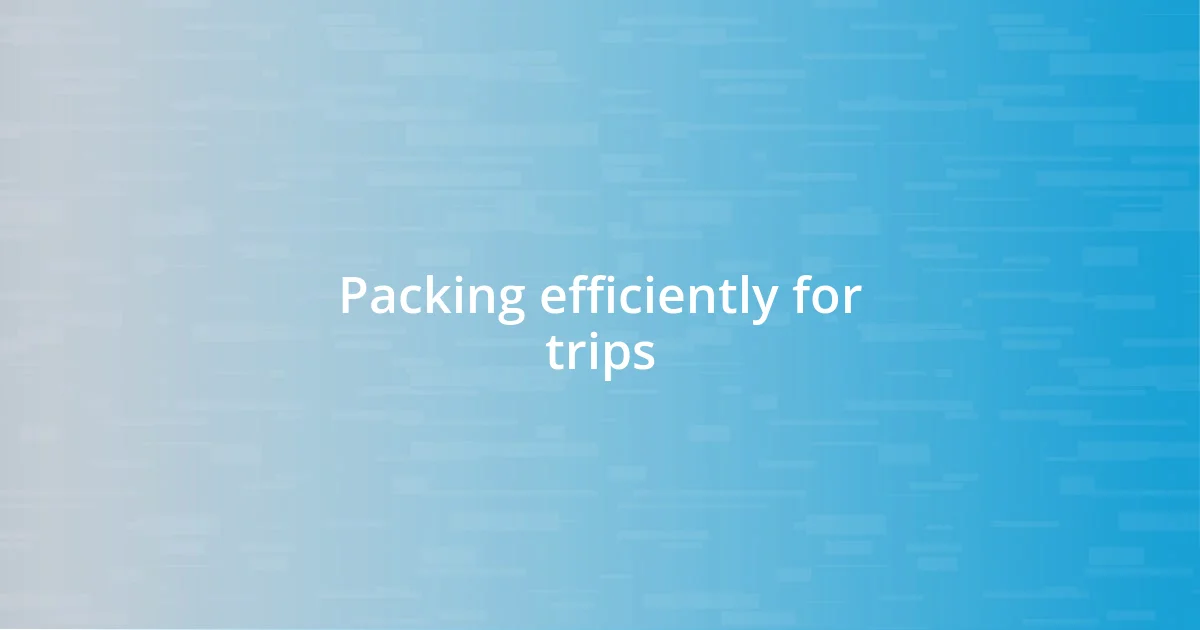
Packing efficiently for trips
Packing efficiently for trips isn’t just about stuffing clothes into a suitcase. It’s an art that I’ve fine-tuned over the years. I still remember my struggle during my first overseas trip; I brought too much, leaving me with a hefty bag and sore shoulders. Now, I embrace the idea of packing light. I focus on versatile clothing items that can be mixed and matched. That way, I can travel comfortably without excessive baggage.
I also make list-making my best friend. Before any trip, I draft a packing list tailored to the destination and activities planned. On my hiking excursions, I prioritize lightweight gear, ensuring every piece serves a purpose. For instance, I wouldn’t dare pack a heavy coat if I know I’ll be enjoying warm weather. Reflecting on my previous trips, I would often find myself regretting items I never wore, like those fancy shoes I packed but ended up leaving behind the entire time.
Staying organized is equally vital. I often use packing cubes to compartmentalize my stuff. It’s like having a mini-closet while on the road! This method not only keeps everything accessible but also minimizes the chaos when rummaging through my bag. Plus, it’s a simple pleasure to see everything neatly organized, don’t you think? Having everything in its place gives me peace of mind, allowing me to enjoy my trip without worrying about misplaced essentials.
| Packing Method | Pros |
|---|---|
| Traditional packing | Less organization, harder to find items |
| Packing cubes | Organized, easy access to items |
| Rolling clothes | Saves space, reduces wrinkles |
| Layering outfits | Versatile, fewer items needed |

Using digital tools effectively
Using digital tools effectively has revolutionized how I plan and organize my trips. I remember my excitement when I first discovered a travel app that consolidated all my bookings. It felt like having a personal assistant right in my pocket! Now, with a quick glance, I can check my flight details, hotel reservations, and even my itinerary. This efficiency not only saves time but also reduces the stress that comes with managing multiple confirmations, right?
Cloud storage has been another game changer for me. Instead of printing out documents, I upload everything to a secure drive, ensuring I can access crucial information from any device. Once, during a vacation in Italy, I realized I forgot to print my museum tickets. Thankfully, I had saved them digitally. I simply pulled them up on my phone, feeling a wave of relief wash over me. It’s small moments like these that remind me how important it is to embrace technology.
Collaborative tools are also fantastic, especially when traveling with friends or family. I often create shared folders for group trips, allowing everyone to contribute ideas and preferences. This approach not only fosters excitement but also ensures that everyone feels included in the planning process. Have you ever planned a trip where one person dominated the decisions? I’ve been there, and it can lead to conflicts. With digital tools, we can pool our thoughts easily and make consensus-driven choices, turning the planning phase into part of the adventure.
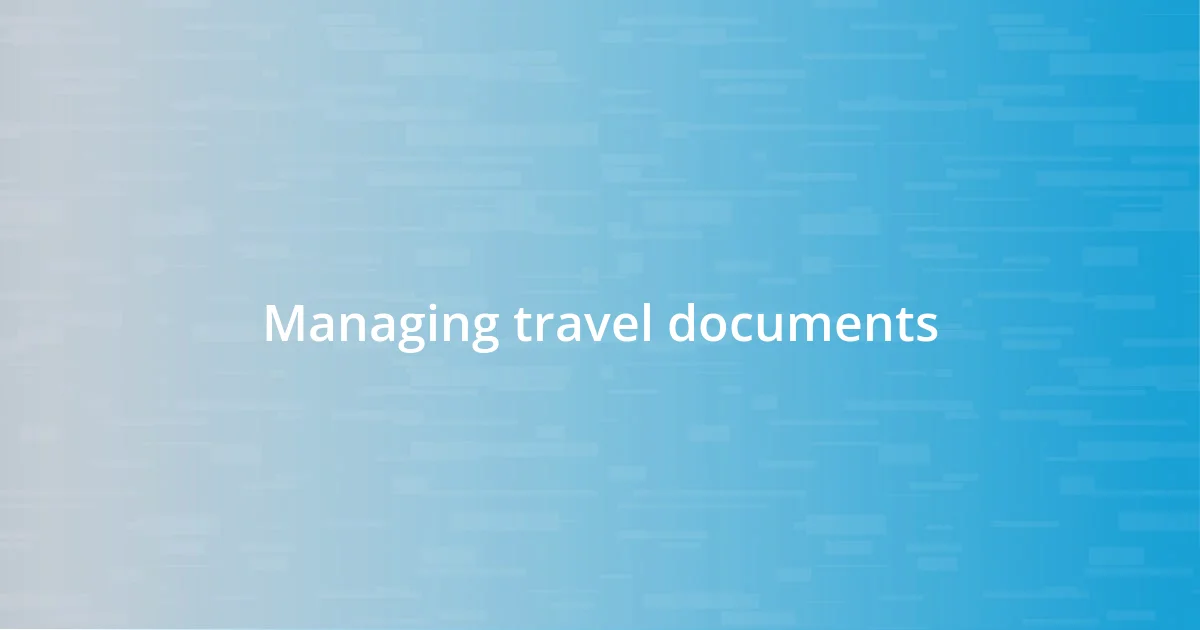
Managing travel documents
Managing travel documents is a crucial part of my travel preparation. I always keep a digital copy of my passport, tickets, and important reservations on my phone. This practice saved me a great deal of stress during a trip to Thailand when I misplaced my printed itinerary. Luckily, I accessed everything I needed in seconds, avoiding what could have been a chaotic situation.
Additionally, I create a dedicated folder on my luggage for physical documents, such as boarding passes and hotel confirmations. I’ve realized that when I have a designated space for these items, it prevents them from getting lost in the shuffle. One time, I found myself rummaging through my bag while boarding a flight, only to discover my boarding pass was buried under layers of clothing. That moment taught me the value of organization in keeping my travel experience smooth.
I often think about how overwhelming travel can feel with all the paperwork involved. A tip that works wonders for me is to sort documents by task; for instance, I use one section for my flight-related docs and another for accommodations. This system not only streamlines the process but also gives me an immense sense of control. Don’t you just love knowing exactly where to find what you need, especially in a bustling airport? It’s a small but satisfying feeling that enhances my travel experience.
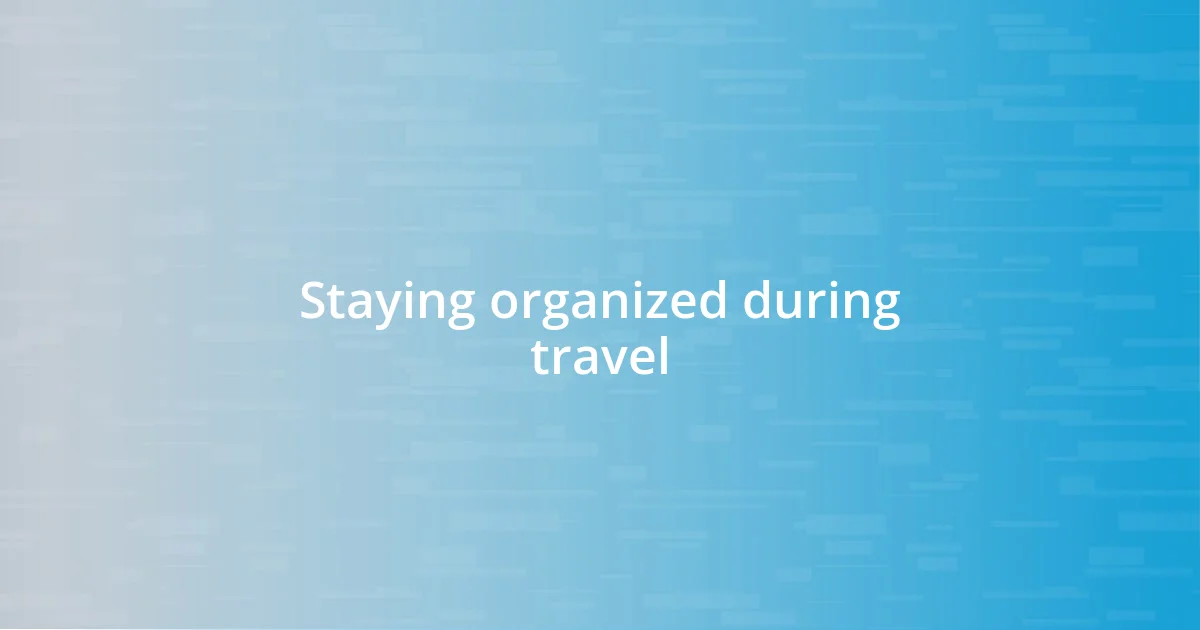
Staying organized during travel
Staying organized during travel can often feel like an elusive goal, yet I’ve discovered some practical strategies that really help. For example, before every trip, I sit down and make a detailed checklist of everything I need to pack, from clothes to chargers. How many times have you arrived at your destination only to realize you forgot a crucial item? I’ve been there, and it’s not a pleasant feeling, especially when I’m halfway around the world.
I also find that dividing my packed items into separate packing cubes brings a sense of clarity to chaos. Each cube has a specific purpose—one for clothing, another for toiletries, and a third for electronics. It sounds simple, but this approach has saved me so much time and energy. Instead of diving into a bottomless pit of my suitcase, I can quickly grab what I need without sifting through piles. I remember a surreal morning in Paris when I effortlessly located my scarf right when the weather turned unexpectedly chilly—what a contrast from my past struggles!
Additionally, I create a travel itinerary that outlines not just transportation and accommodations, but also daily activities. This practice keeps my days on track; I even include local restaurant recommendations. Picture this: you’ve just arrived in a city, and dinner is looming. Instead of wandering aimlessly, I can turn to my plan and easily find a spot that aligns with my cravings. Have you experienced the joy of a spontaneous meal that hits the spot? That’s the kind of thrill I aim for, but I prefer to have a roadmap to guide those moments!
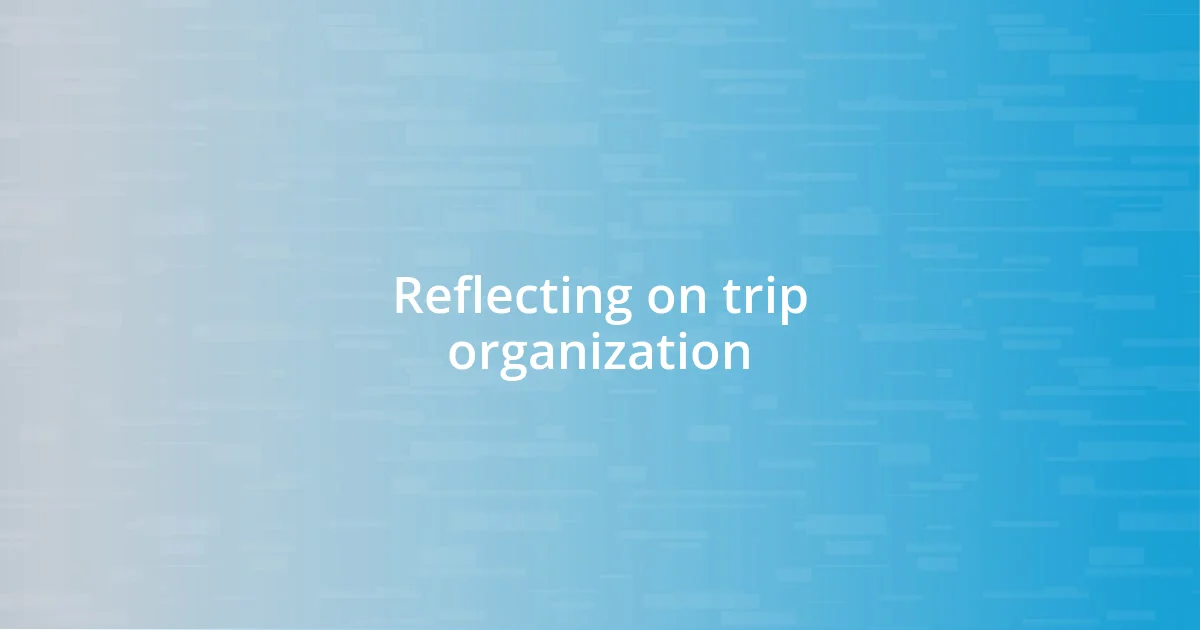
Reflecting on trip organization
Reflecting on how I organize trips often leads me to realize the impact of a well-planned approach. When I look back, I remember a trip to Italy that was a game changer. With everything mapped out, from transportation to sightseeing, my experience was not just enjoyable but deeply enriching. Who knew that a little organization could transform chaos into discovery?
I often find myself considering the emotional weight that can come with disorganization. There was a time in Japan when my friend and I hit a wall because we didn’t have our plans straight. The stress of figuring out where to go next made us miss the chance to explore a hidden gem nearby. In hindsight, I realize how important it is to embrace proactive planning; it allows room for spontaneity while still ensuring I hit all the major highlights. Isn’t it funny how a well-structured trip can provide the freedom to explore more naturally?
Sometimes I also reflect on the friendships and connections formed when I stay organized. I vividly recall meeting fellow travelers in a bustling hostel, and because I had my itinerary organized, I was able to suggest fun excursions. Sharing experiences, taking spontaneous detours, and being open to new adventures has always enhanced my travels. Isn’t organization about more than just the logistics? It’s about creating memories and building relationships that last a lifetime.



